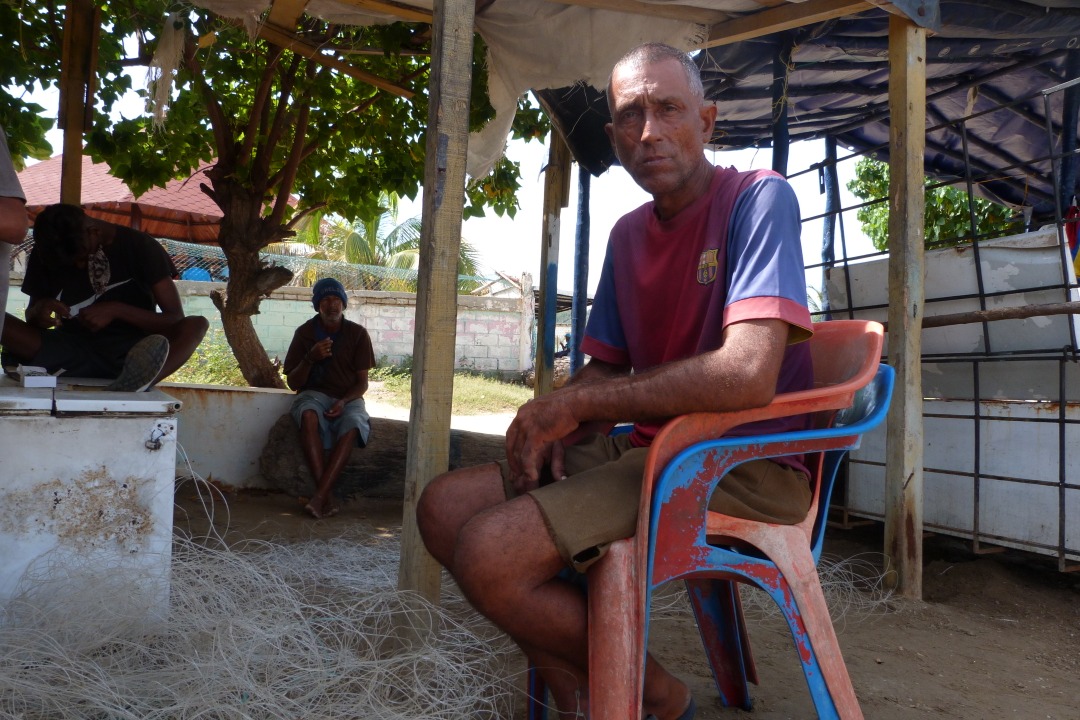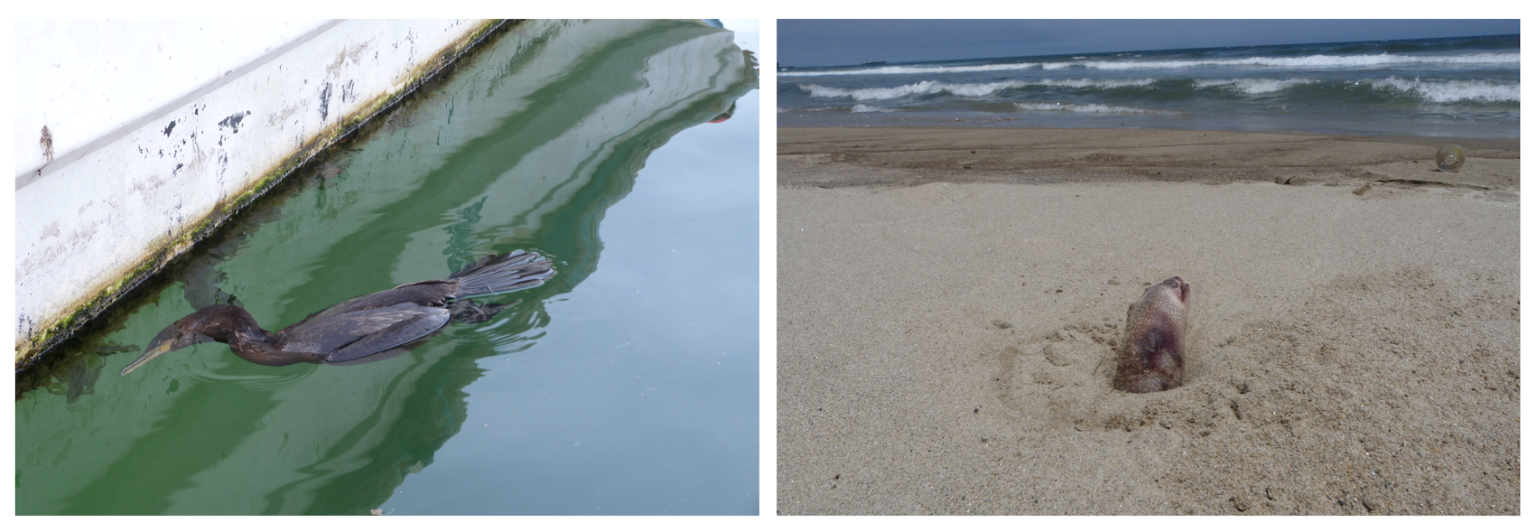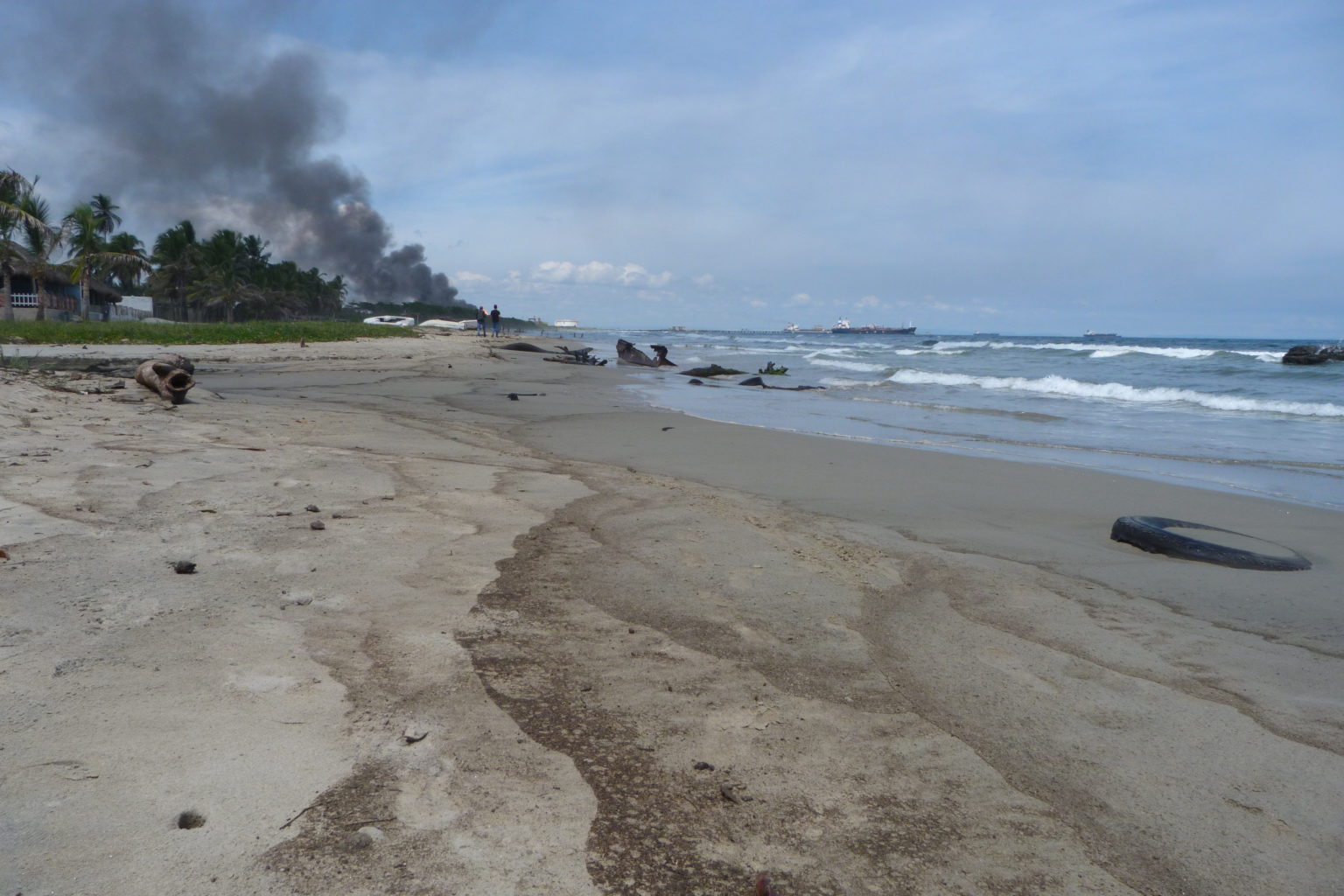Swimming and Fishing in a Sea of Oil
The only thing a formerly great oil industry has left to show for is a daily environmental disaster. That’s life on the Carabobo coastline, while PDVSA is still unable to put a plug on its spills


“The first sign of an oil spill is the smell.”
Photo: Armando Díaz
Samuel Berti had been sailing since the previous afternoon for the past 14 nautical miles from Puerto Cabello, off the coast of Carabobo, when he noticed a dark liquid twisting and expanding over the water. On the surface, it would make an iridescent mosaic that changed with the angle of the sun.
Samuel looked at his partner. The nets had been in the water for hours, and he knew the results wouldn’t be good. It has happened before and it’s common to see oil floating on local waters, so when he pulls the fish out, he has remove the chemical layers with a stick.
“It’s horrible, my brother,” he says. “I have to remove all that pollution, when the fish comes out, it has oil coming out of its mouth.”
That day, the fisherman with over 30 years of experience warned that instead of the 40 or even 80 kilos of fish they’d get in one day, they get nothing instead.
“Those fish took off. You can’t get mackerels. There aren’t sardines anymore either, which this time of year should be a quite common sight.”
When they picked up their nets and buoys, they were tainted black and had a very strong asphalt smell. He then thought of all the money he’d have to spend; the nylon roll costs $40 and the box of small fishing hooks is $8. If he’s lucky, he’ll make ten million bolivars in a month, while in the good old days he’d make eight million a week.
When they return to the beach, the other boats are dirty too. Although dead fish don’t usually wash up in their area, there’s a dead cormorant floating by the dock. The bird doesn’t smell bad, but it has dark grey, almost black, stains. A ten-year-old boy is fishing with a line and without luck.
Samuel eagerly waits for the waters to clear up, but the El Palito refinery doesn’t slow down. As soon as the fish come back, more waste goes into the sea.
“When the water feels warm, that’s when you know it isn’t right.”
El Palito Starts Running—and Killing Everything
So far this year, El Palito has had three big oil spills, all three denounced by Eduardo Klein, director of the Remote Sensors Laboratory at Universidad Simón Bolívar, who checks the satellite images every morning while he drinks his coffee. It was July 21st when he spotted a huge black oil stain on the satellite images, so he checked the past few days; there was no stain on the 19th.
According to this expert, there was an error in the catalytic cracking plant of the refinery, which normally pours the hydrocarbons it didn’t process into the disposal wells. Being only one meter deep, these wells overflow if hydrocarbons continue to go in before they’re decanted and properly disposed of.

It’s been three decades for Samuel Berti fishing on the Carabobo coast, yet it’s the first time he has had to deal with the economic impact of oil spills.
Photo: Armando Díaz
Klein estimates that the first spill was of about 26,000 oil barrels. On August 8th, the second spill happened, when heavy rains dragged the contents of the disposal wells out. The third one came in mid-October.
“I’m bothered by exaggerations made from both sides,” says Pánfilo Masciangioli, an expert in oil spills. “The government says that nothing happened, and that’s not true.”
Masciangioli worked in PDVSA for 30 years. During that time, he was a researcher, Ecology and Environment manager, and manager for the Integrated Handling of Gas. José Gregorio Vielma Mora, candidate for chavismo in the upcoming parliamentary elections, told Caracas Chronicles:
“I’ve been there and the spill isn’t that bad, but the fact is that we can’t have a single drop of oil spilled. That’s already a serious problem, and if they have to question someone, so be it, but I can’t deny something that everyone has seen.”
The Smell of a Spill
Cecilia Vásquez has worked at the beach in El Palito for 12 years. The pandemic killed her sunshade tents rental business and PDVSA gave the final blow. Her head, eyes, and throat are burning:
“The vice minister and a PDVSA manager came by and told us that the spill wasn’t from the refinery. It was a tanker giving trouble. The truth is, seeing the amount that came out, I don’t know if it was a tanker being cleaned out or what, but there’s diesel still lingering.”
Cecilia had to settle for that explanation. They only told her that they’d give her three million bolivars a week (less than three dollars at the time of writing), to clean out the beach, along with others in the community. She’d also get a bag of food that has been just a promise for several months now.
Being there gives her headaches, but Cecilia is laying on a beach chair with some neighbors.
“The first sign of an oil spill is the smell,” she explains. “It isn’t strong today.”
That was on October 8th, five days before the third spill.

The effect on the local fauna is painful to watch.
Photo: Armando Díaz
Osmary Saavedra was born and raised on that shore. She’s 29 and sees her children, all under the age of ten, bathing in those waters that leave black stains in the sand and the skin. The fear’s there, but she has learned to get over it.
“We’re used to it, but this shouldn’t happen. Our children like to swim here, and this affects them.”
The Invisible Spills
Eduardo Klein explains that when all of this waste goes into the sea, they sink and clump at the bottom; some of it is taken by the currents to the shore, some evaporates, and some of it floats and is moved around by the winds. The smell Cecilia refers to comes from the evaporating hydrocarbons.
“Other spills from El Palito go out and get lost at sea,” Klein says. “Or they reach the Morrocoy National Park.”
Klein warns that the problem is even worse in the Complejo Refinador de Paraguaná, or CRP, made up of Amuay and Cardón, where oil spills are ongoing, more polluting, and less degraded. In August, the oil pipeline Surtidor Falcón Zulia (Sufaz) spent several weeks leaking gas from a crack. Pánfilo Masciangioli explains that what’s happening there is the result of oil pipelines being paralized, so when the pipe is emptied and the pumping process is reactivated again, a phenomenon called “battering ram” is created, in which an internal pressure wave goes through the pipe, fracturing it.
Now the CRP is setting off the alarms: the number 3 separator in Cardón has so many leaks that you can see them from satellites. On October 15th, a disposal well in Amuay began spilling hydrocarbons.
One Hundred Years Bathing in Oil
It’s harder to catch the spills in the Maracaibo Lake, but they’ve been going on for years. Five million barrels of oil were spilled in the Gulf of Mexico, yet Masciangioli explains that that same amount is spilled in the Maracaibo Lake every year, from natural oil springs constantly letting oil out. The pipelines also spill their contents through cracks.
Historian Laura Puertas wrote in her book Los Paisajes Petroleros del Zulia en la mirada alemana (1920-1940) that on December 18th, 1926, fishermen from the Maracaibo Lake wrote a letter in protest which was published in the press, and in 1928 the first complaint was issued to the Executive Branch, so laws were passed to prevent pollution, but nothing changed. In 1935, German traveler Julia Bornhorst wrote in her memoirs how the oil towers, then built on wooden piling, would constantly catch fire.
Now, the Maracaibo Lake, with its 5,000 wells in over 13,200 square kilometers, has become a huge dumping site which affects over 200 kilometers of coastline and it has drastically changed the residents’ lifestyle. The prosperity is over and only the memories of a faraway greatness remain, of an industry bleeding out oil, while the 300,000 residents in Cabimas walk on the stained pavement. The local administration just tries to cover up their glaring mistakes, literally, with sand.

The beaches near the El Palito refinery, already victims of a decades-long pollution, are deteriorating further.
Photo: Armando Díaz
Zulia has had four big oil spills in 2020. It’s the leading state, along with Anzoátegui, in these types of events. You can see on Google Maps the black streak floating on the green waters with algae and cyanobacteria.
Deterioration Is Key
Pánfilo Masciangioli, who was an advisor for PDVSA during the oil spill in the Mexican Gulf on April 20th, 2020, explains that it’s impossible to separate the events of PDVSA and the deterioration and lack of maintenance. Masciangioli says that natural oil spills can happen anywhere in the world. “It’s not that it’s not worrying, but we have to live with that.” What’s truly worrying is the wear of the facilities.
“An oil spill is like a car accident. Accidents happen, but the risk increases if the car has worn tires and the road is filled with potholes. In oil production facilities you have to use corrosion prevention, protective rings and electrical anti-corrosion systems every few meters; but it has all been neglected in the past 15 years. Now with the sanctions, the drop in oil prices and the pandemic, a lot of PDVSA workers stay home. Few operators are actually working.”
The expert’s fear is that each time they try to reactivate any oil infrastructure, accidents and spills will occur. When they forced the El Palito refinery without doing any maintenance first, the 2020 spills happened.
“Each time you turn things on, there’s high pressure and temperature. Explosions or fires can break out. You can have catastrophes, and they will happen. They haven’t happened because there hasn’t been enough activity, but once they start in full again, they will.”
Shades of Black
Unlike many ecologists, Pánfilo Masciangioli believes that the worse thing isn’t the amount of oil that’s being spilled, it’s the type of hydrocarbon.
“From the biological and recovery point of view, it’s not that serious. But, the lighter the oil, the more toxic it is. Gasoline is very toxic, but it evaporates quickly. With heavy crude oil, not many fish will die because as soon as they smell it they run away, but it does kill living creatures in the sea basin and the mangroves. With time, most of these areas will recover.”
Meanwhile, a Provea report says that between 2010 and 2018, PDVSA spilled 866,722.85 barrels of oil into the environment, not just into the sea, like it has occurred recently in the coasts of Falcón and Carabobo, but also in lakes, rivers and fields.
From 2010 to 2016 the oil industry had accumulated a total of 46,820 oil spills and other polluting agents into the environment.
Caracas Chronicles is 100% reader-supported.
We’ve been able to hang on for 22 years in one of the craziest media landscapes in the world. We’ve seen different media outlets in Venezuela (and abroad) closing shop, something we’re looking to avoid at all costs. Your collaboration goes a long way in helping us weather the storm.
Donate




